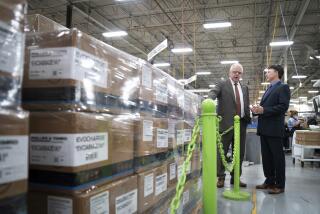Medical Device Industry Helps Minnesota’s Health
- Share via
MINNEAPOLIS — Minnesota’s economy is a big reason Mike Mack didn’t miss a beat when he switched jobs last spring.
After surviving several rounds of firings at mainframe computer maker Unisys Corp., the 33-year-old electrical engineer wanted more stable work with brighter career prospects. So Mack joined Minneapolis-based Medtronic Inc., the world’s largest pacemaker company.
Instead of programming consoles for mainframe computers, he now works on the increasingly sophisticated electronics used to treat hearts that beat too fast or too slow.
“Medical devices are growing very rapidly in Minnesota and the mainframe computer business seemed to be dwindling,” Mack said. His programming skills also will be put to good use, as medical devices are becoming increasingly computerized.
Minnesota’s economy has been propelled by several industries, particularly software and electronics, and by the presence of plenty of skilled workers like Mack. That has kept its jobless rate low at just 3.8%, well under the 5.1% national rate in August. Minneapolis-St. Paul, at 2.8%, has the lowest rate among the nation’s 25 biggest metropolitan areas.
The most notable growth is in medical technology among companies such as Medtronic, St. Jude Medical Inc., Guidant Corp. and Boston Scientific Corp. that make catheters, pacemakers and other expensive devices. Because of the concentration of such companies in the suburban towns such as Fridley and Brooklyn Park north and west of Minneapolis, the area has picked up the nickname “Medical Alley.” Employment in the industry grew 6.2% in the last year, to 17,800 in August.
“Medical devices have led the parade in terms of jobs,” said Larry Wipf, a Norwest Corp. economist. “No other industry has come close.”
And the jobs pay well--about $4,000 better than the average manufacturing wage of $33,400 in Minnesota. State personal income in the first quarter jumped 6.9% from a year earlier, the biggest gain in the Midwest and well above the 5.0% gain nationally.
“The most persuasive factor [in Minnesota’s economic momentum] is how strong the job market is, especially for skilled workers,” said Paul Anton of Bugbee, Anton & Associates, a Minneapolis-based economics consulting firm. Workers who did lose their jobs quickly found work elsewhere because of the state’s diversified economy.
Such growth comes amid the biggest migration into Minnesota since the 1960s, a 4.3% rise since 1990. Farm income also improved since floods hit the state’s southern region a few years ago.
And some of state’s largest employers have reported improved financial performance, as Minnesota maintains a strong high-technology sector. Honeywell Inc. has been helped by a rebound in its aviation-equipment business, while United HealthCare Corp. has expanded the reach of its health-care plans through several major acquisitions.
The Minnesota economy also got help from changes in the state’s workers’ compensation laws. The average cost last year fell to $4.64 per $100 of payroll, from $5.47 in 1994, and it now has the 19th lowest workers’ comp rate in the nation.
Much of that economic expansion is concentrated in Minneapolis and St. Paul. Retail sales in the metro area rose 7.6% in July from a year earlier, and 6.2% for the year to date, better than the 5.9% national average.
Real estate is strong, too. The market for office space is the tightest in 12 years, with only a 3.9% vacancy rate in downtown Minneapolis. Home sales in the Twin Cities rose more than 26% to $2.93 billion in the first eight months of 1996, with the average price up 7% to $126,800. Housing permits, meanwhile, rose 18.5%, to 7,404.
More to Read
Inside the business of entertainment
The Wide Shot brings you news, analysis and insights on everything from streaming wars to production — and what it all means for the future.
You may occasionally receive promotional content from the Los Angeles Times.










